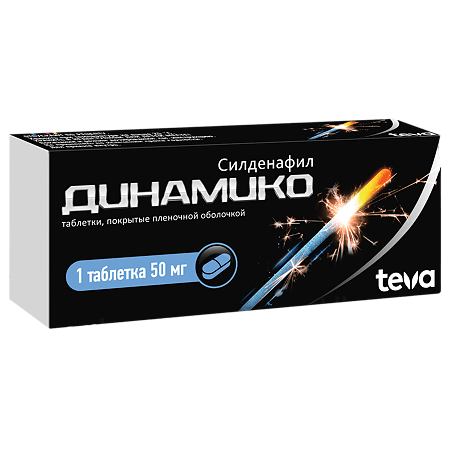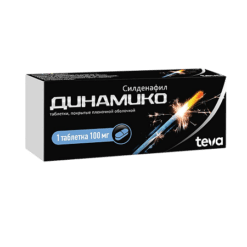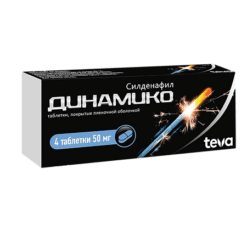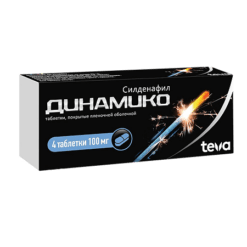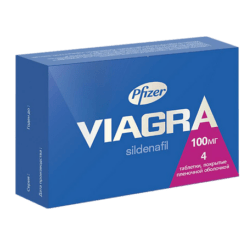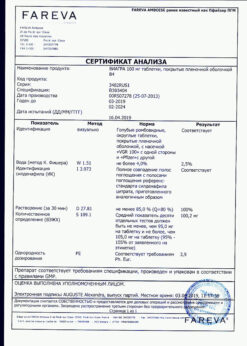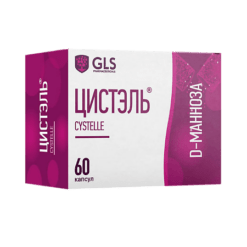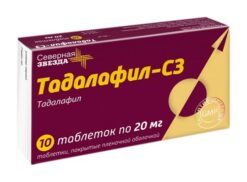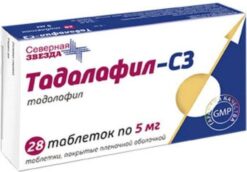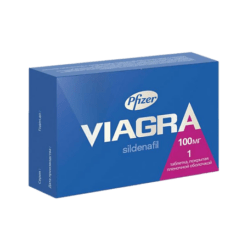No products in the cart.
Dynamico, 50 mg
€19.83 €16.52
Description
AtCode: G04BE03
Pharmacological properties
Pharmacodynamics.
The erectile dysfunction drug restores impaired erectile function under sexual stimulation by increasing blood flow in the penis.
The physiological mechanism of erection involves the release of nitric oxide (NO) in the cavernous body due to sexual arousal. NO activates the enzyme guanylate cyclase, which leads to an increase in cyclic guanosine monophosphate (cGMP). In turn, cGMP causes the smooth muscles of blood vessels to relax and, consequently, the flow of blood into the cavernous body of the penis.
Sildenafil is a selective inhibitor of cGMP-specific phosphodiesterase type 5 (PDE5), which causes the breakdown of cGMP in the cavernous body of the penis. It does not have a direct relaxing effect on the smooth muscles of the cavernous body, but it enhances the relaxing effect of nitric oxide on this tissue and increases blood flow in the
C penis. During activation of the NO – cGMP chain observed during sexual stimulation, inhibition of FDE5 leads to an increase of cGMP in the cavernous body. The pharmacological effect is achieved only in the presence of sexual stimulation.
The activity of sildenafil in relation to FDE5 is superior to other known phosphodiesterase isoenzymes: FDE6 – 10 times, FDE1 – more than 80 times; FDE2 – FDE4, FDE7-FDE11 – more than 700 times. Sildenafil is 4,000 times more selective against FDE5 compared with FDE3, which is important because FDE3 is one of the key enzymes regulating myocardial contractility.
Sildenafil has a mild and short-lived hypotensive effect, in most cases with no clinical manifestation when taken at recommended doses. The hypotensive effect is due to the vasodilatory effect of sildenafil due to an increase in cGMP in the vascular smooth muscle membrane.
Clinical data
Cardiology studies
The use of sildenafil in doses up to 100 mg did not result in clinically significant ECG changes in healthy volunteers. The maximum decrease in systolic blood pressure in the supine position after sildenafil administration at a dose of 100 mg was 8.3 mm Hg, and in diastolic blood pressure, 5.3 mm Hg. A more pronounced, but also transient effect on blood pressure (BP) was noted in patients taking nitrates (see “Contraindications” and “Interaction with other medications”).
In a study of the hemodynamic effects of sildenafil at a single dose of 100 mg in 14 patients with severe coronary heart disease (CHD) (more than 70% of patients had stenosis of at least one coronary artery), resting systolic and diastolic BP decreased by 7% and 6%, respectively, and pulmonary systolic BP decreased by 9%. Sildenafil did not affect cardiac output or impair blood flow in stenosed coronary arteries, and it also resulted in an increase (by approximately 13%) in adenosine-induced coronary flow in both stenosed and intact coronary arteries.
In a double-blind, placebo-controlled study, 144 patients with erectile dysfunction and stable angina taking antianginal drugs (except nitrates) exercised until the severity of angina symptoms decreased. Exercise duration was significantly longer (19.9 seconds; 0.9 to 38.9 seconds) in patients taking sildenafil in a single dose of 100 mg compared to patients receiving placebo.
A randomized, double-blind, placebo-controlled study examined the effect of a variable dose of sildenafil (up to 100 mg) in men (n = 568) with erectile dysfunction and arterial hypertension taking more than two antihypertensive drugs. Sildenafil improved erections in 71% of men compared with 18% in the placebo group. The incidence of adverse effects was comparable to that in other patient groups, as well as in those taking more than three antihypergenic drugs.
Studies on visual impairment
In some patients, a mild and transient impairment in the ability to distinguish shades of color (blue/green) was detected 1 hour after taking sildenafil at a dose of 100 mg using the Farnsworth-Munsel 100 test. These changes were absent 2 hours after taking the drug. The color vision impairment is thought to be caused by inhibition of FDE6, which is involved in the transmission of light in the retina. Sildenafil had no effect on visual acuity, contrast perception, electroretinogram, intraocular pressure, or pupil diameter.
In a placebo-controlled, crossover study of patients with proven early-onset macular degeneration (n = 9), sildenafil at a single dose of 100 mg was well tolerated. There were no clinically significant changes in vision as assessed by specific visual tests (visual acuity, Amsler grid, color perception, color passage simulation, Humphrey perimeter, and photostress).
The efficacy and safety of sildenafil were evaluated in 21 randomized, double-blind, placebo-controlled trials lasting up to 6 months in 3000 patients aged 19 to 87 years with erectile dysfunction of various etiologies (organic, psychogenic, or mixed). Efficacy of the drug was evaluated globally using an erection diary, the International Erectile Function Index (a validated sexual function questionnaire), and a partner survey.
The efficacy of sildenafil, defined as the ability to achieve and maintain an erection sufficient for satisfactory intercourse, has been demonstrated in all studies conducted and has been confirmed in long-term studies lasting 1 year. In fixed-dose studies, the proportion of patients reporting that therapy improved their erections was 62% (sildenafil 25 mg dose), 74% (sildenafil 50 mg dose), and 82% (sildenafil 100 mg dose), compared with 25% in the placebo group. Analysis of the International Index of Erectile Function showed that in addition to improved erections, sildenafil treatment also improved the quality of orgasm, allowed to achieve satisfaction of intercourse and overall satisfaction.
The pooled data showed that 59% of patients who reported improved erections with sildenafil treatment were diabetic patients, 43% of patients who had undergone radical prostatectomy, and 83% of patients with spinal cord injury (versus 16%, 15%, and 12% in the placebo group, respectively).
Pharmacokinetics
The pharmacokinetics of sildenafil in the recommended dose range are linear.
Absorption. After oral administration, it is rapidly absorbed. Maximum plasma concentration (Cmax) when taken on an empty stomach is reached within 0.5-2 hours, bioavailability is on average 41% (25-63%). In vitro sildenafil at a concentration of about 1.7 ng/ml (3.5 nM) inhibits human FDE5 activity by 50%. When taken in combination with fatty foods the absorption rate is reduced: Cmax is reduced by an average of 29% and the time to reach maximum concentration (Tmax) is increased by 60 minutes, but the degree of absorption is not significantly changed (the area under the pharmacokinetic curve of concentration-time (AUC) is reduced by 11%).
Distribution. The apparent volume of distribution in the equilibrium state is 105 liters. The binding of sildenafil and its main active metabolite to plasma proteins is 96% of the administered dose and is not dose-dependent. Less than 0.0002% of the sildenafil dose (188 ng on average) is detected in semen 90 min after drug administration.
Metabolism. Sildenafil is metabolized mainly by the liver microsomal isoenzymes CYP3A4 (main pathway) and CYP2C9 (additional pathway). The main circulating active metabolite is N-desmethylmetabolite (N-desmethyl metabolite), whose activity against phosphodiesterase is 50% of sildenafil activity and its plasma concentration reaches 40% of sildenafil concentration. N-desmethylmetabolite undergoes further metabolism with a half-life of 4 hours.
Elimation. Total clearance of sildenafil is 41 l/h. The half-life (T½) of sildenafil is 3-5 hours. Inactive metabolites are excreted through the intestine (80%) and the kidneys (13%).
Pharmacokinetics in special groups of patients.
In healthy patients over 65 years of age, the Cmax of sildenafil and its active metabolite is increased by approximately 90% compared to younger patients (18-45 years) due to decreased sildenafil clearance. Plasma concentrations of free sildenafil are approximately 40% higher in older patients than in younger patients.
Age has no clinically significant effect on the incidence of side effects.
In patients with mild (creatinine clearance 50-80 ml/min) and moderate (creatinine clearance 30-49 ml/min) renal impairment, the pharmacokinetics of sildenafil are not altered by taking 50 mg, and Cmax and area under the concentration-time curve (AUC) for N-desmethylmetabolite are increased by 73% and 126%, respectively. In patients with severe renal impairment (creatinine clearance less than 30 mL/min), Cmax and AUC are increased by 88% and 100%, respectively, Cmax and AUC of N-desmethylmetabolite are increased by 79% and 200%, respectively.
In patients with cirrhosis (Child-Pugh grades A and B), Cmax and AUC are increased by 47% and 84%, respectively.
The pharmacokinetics of sildenafil in patients with severe hepatic impairment (Child-Pugh class C) have not been studied.
Indications
Indications
Treatment of erectile dysfunction, characterized by the inability to achieve or maintain penile erection sufficient for satisfactory sexual intercourse.
Effective only with sexual stimulation.
If there is no improvement or you feel worse, you should consult a doctor.
Special instructions
Special instructions
Driving vehicles and working with machinery
Dynamico may cause dizziness and affect vision. Before driving or operating machinery, you should know how Dynamico affects you.
The drug Dynamico contains lactose monohydrate
If your doctor has told you that you have an intolerance to certain sugars, talk to your doctor before taking this drug.
Active ingredient
Active ingredient
Sildenafil
Composition
Composition
The active ingredient is sildenafil.
Dynamico, 25 mg, film-coated tablets
Each tablet contains 35.12 mg of sildenafil citrate (equivalent to 25.00 mg of sildenafil).
Dynamico, 50 mg, film-coated tablets
Each tablet contains 70.24 mg of sildenafil citrate (equivalent to 50.00 mg of sildenafil).
Dynamico, 100 mg, film-coated tablets
Each tablet contains 140.48 mg of sildenafil citrate (equivalent to 100.00 mg of sildenafil).
Other ingredients (auxiliary substances) are: microcrystalline cellulose (PH 101); croscarmellose sodium; hyprolose (hydroxypropylcellulose); colloidal silicon dioxide (anhydrous colloidal silicon dioxide); magnesium stearate; Opadry II 31F58914 white (hypromellose (E 464), lactose monohydrate, titanium dioxide (E 171), macrogol-4000, sodium citrate dihydrate (E 331)); indigo carmine (E 132).
Pregnancy
Pregnancy
Dynamico is not intended for use in women.
Contraindications
Contraindications
Do not take Dynamico:
if you are allergic to sildenafil or any of the other ingredients of the medicine listed in section 6 of the leaflet;
if you are constantly or intermittently taking nitric oxide donors, organic nitrates or nitrites in any form, since sildenafil enhances the hypotensive effect of nitrates;
together with guanylate cyclase stimulants such as riociguat, as this may lead to symptomatic hypotension;
simultaneously with other drugs for the treatment of erectile dysfunction, since the safety and effectiveness of the use of sildenafil in such combinations has not been studied;
if you have lactose intolerance, lactase deficiency, glucose-galactose malabsorption (a condition in which intestinal cells cannot absorb sugars – glucose and galactose);
if you have severe liver failure;
simultaneously with ritonavir;
if you are a patient for whom sexual activity is not recommended (for example, patients with severe cardiovascular disease such as unstable angina or severe chronic heart failure);
if you have had a myocardial infarction or stroke within the last 6 months; if you have life-threatening arrhythmias (impaired frequency, sequence and rhythm of heart contractions, which can cause circulatory disorders, cardiogenic shock, sudden cardiac death), arterial hypotension (low blood pressure less than 90/50 mm Hg) or arterial hypertension (high blood pressure more than 170/100 mm Hg);
if you are a patient with episodes of anterior non-arteritic ischemic optic neuropathy (a condition involving loss of vision due to damage to the optic nerve) with loss of vision in one eye, whether these episodes were related to previous use of a PDE5 inhibitor or not;
for hereditary degenerative diseases of the retina, including retinitis pigmentosa.
Special instructions and precautions
Before taking Dynamiko, consult your doctor.
Dynamico should be used with caution if you have:
curvature (deformation) of the penis, visible in a state of erection (angulation, cavernous fibrosis or Peyronie’s disease);
diseases predisposing to the development of priapism – prolonged painful erection of the penis, not associated with sexual arousal: sickle cell anemia, multiple myeloma, leukemia, thrombocythemia;
diseases accompanied by bleeding;
peptic ulcer of the stomach and duodenum in the acute stage;
liver failure of mild to moderate severity;
severe renal failure;
simultaneous use of alpha-adrenergic receptor blockers.
Cases of prolonged erection and priapism have been reported. If an erection persists for more than 4 hours, you should immediately seek medical help. If priapism is not treated immediately, it can lead to damage to the tissue of the penis and irreversible loss of potency.
Medicines intended to treat erectile dysfunction should not be used by men for whom sexual activity is undesirable.
Sexual activity poses a certain risk in the presence of heart disease, so before starting any treatment for erectile dysfunction, a cardiovascular examination should be performed.
Hypotension (low blood pressure)
Sildenafil has a systemic vasodilatory effect, leading to a transient decrease in blood pressure, which does not lead to any consequences in most patients. Before using the drug, it is necessary to carefully assess the risk of possible undesirable manifestations of the vasodilator effect in the presence of relevant diseases, especially against the background of sexual activity.
Since the combined use of sildenafil and α-blockers can lead to symptomatic hypotension in some sensitive patients, the drug should be used with caution in patients taking α-blockers (see subsection “Other drugs and Dynamico”). To minimize the risk of postural hypotension (a condition in which blood pressure drops sharply when changing body position from a sitting or lying position to a standing position) in patients taking α-blockers, sildenafil should be started only after hemodynamic stability has been achieved in these patients. You should also consider the advisability of reducing the initial dose of sildenafil (see section “Taking the drug Dynamic”). The physician should inform patients about what actions to take if symptoms of postural hypotension occur.
Visual impairment
In rare cases, non-arteritic anterior ischemic optic neuropathy (NAIOPN), a rare disease and cause of decreased or loss of vision, has been reported during use of all PDE5 inhibitors, including sildenafil. Most of these patients had risk factors, including decreased papilledema/disc ratio (“congestive disc”), age over 50 years, diabetes mellitus, hypertension, coronary artery disease, hyperlipidemia, and smoking. In case of sudden loss of vision, you should stop sildenafil therapy and consult your doctor immediately. Individuals who have already had a case of NPIND have an increased risk of recurrent NPIND. PDE5 inhibitors, including sildenafil, should be used with caution in such patients and only in situations where the expected benefit outweighs the possible risk. In patients with episodes of NPINS development with loss of vision in one eye, sildenafil is contraindicated (see section “Contraindications”).
There is no information on the safety of the drug in patients with retinitis pigmentosa (a hereditary eye disease that causes severe vision impairment and often blindness), therefore sildenafil should not be used in such patients (see subsection “Contraindications”).
Hearing impairment
Some studies have reported cases of sudden deterioration or loss of hearing associated with the use of all PDE5 inhibitors, including sildenafil. Most of these patients had risk factors for sudden deterioration or loss of hearing. A cause-and-effect relationship between the use of PDE5 inhibitors and sudden hearing loss or deterioration has not been established. If there is a sudden deterioration in hearing or hearing loss while taking sildenafil, you should consult your doctor immediately.
Bleeding
Sildenafil enhances the antiplatelet effect (anti-clotting effect) of sodium nitroprusside, a nitric oxide donor, on human platelets in vitro. There are no data on the safety of sildenafil in patients with a tendency to bleeding or exacerbation of gastric and duodenal ulcers, so the drug should be used with caution in these patients. The incidence of epistaxis in patients with pulmonary hypertension associated with diffuse connective tissue diseases was higher (sildenafil 12.9%, placebo 0%) than in patients with primary pulmonary arterial hypertension (sildenafil 3.0%, placebo 2.4%). Patients receiving sildenafil in combination with a vitamin K antagonist had a higher incidence of epistaxis (8.8%) than patients not taking a vitamin K antagonist (1.7%).
Use in conjunction with other means of treating erectile dysfunction
The safety and effectiveness of sildenafil in combination with other PDE5 inhibitors or other drugs for the treatment of pulmonary arterial hypertension containing sildenafil, or other drugs for the treatment of erectile dysfunction, therefore the use of such combinations is contraindicated.
Children and teenagers
The drug Dynamico is contraindicated for use in children and adolescents under 18 years of age.
Side Effects
Side Effects
Like all medicines, Dynamico can cause side effects, although not everyone gets them.
You should stop taking Dynamico and seek immediate medical attention if you experience any of the following adverse reactions:
skin rash, swelling of the face, lips, tongue or throat, hives (sudden widespread rash of itchy blisters of an allergic nature), difficulty breathing or swallowing (the first signs of an anaphylactic reaction);
sudden loss of vision.
The most common side effects are headache and flushing. Typically, the side effects of sildenafil are mild or moderate and temporary. Fixed-dose studies have shown that the incidence of some adverse events increases with increasing dose.
There are also other undesirable reactions:
Common reactions (may affect up to 1 in 10 people):
blurred vision, blurred vision, cyanopsia (a condition in which everything around you appears blue);
“tides”;
nasal congestion;
nausea, dyspepsia (indigestion);
back pain;
dizziness.
Uncommon reactions (may affect up to 1 in 100 people):
hypersensitivity reactions (including skin rash), allergic reactions;
pain in the eyes, photophobia (photophobia), photopsia (appearance in the field of vision of objectless images: moving dots, spots, figures, lightning, often luminous, shiny), chromatopsia (distortion of color sensations, in which only one of the primary colors is perceived), redness of the mucous membrane of the eyes/injection of the sclera, change in the brightness of light perception, mydriasis, conjunctivitis (inflammation mucous membrane of the eye), hemorrhage in the eye tissue, cataracts, disruption of the lacrimal apparatus;
sudden decrease or loss of hearing, noise, ringing in the ears, ear pain;
tachycardia (increased heart rate), palpitations, decreased blood pressure, increased blood pressure, unstable angina, atrioventricular block, myocardial infarction, cerebral thrombosis, cardiac arrest, heart failure, abnormalities in electrocardiogram readings, cardiomyopathy (a general name for diseases with an unclear cause of development with selective damage to the heart muscle);
anemia (reduced hemoglobin content in the blood, as well as erythrocytes/red blood cells), leukopenia (reduced white blood cell content);
feeling of thirst, edema, gout (a disease with the deposition of uric acid salts in tissues and with the development of inflammatory and destructive changes in them), uncompensated diabetes mellitus, hyperglycemia (increased blood glucose), peripheral edema, hyperuricemia (increased uric acid), hypoglycemia (low blood glucose), hypernatremia (deficiency of the total amount of water in the body according to relative to total sodium content);
nosebleeds, rhinitis, bronchial asthma, dyspnea (impaired frequency, rhythm and depth of breathing with feelings of lack of air or difficulty breathing), laryngitis, pharyngitis, sinusitis, bronchitis, increased volume of sputum, increased cough;
gastroesophageal reflux disease, vomiting, abdominal pain, dry oral mucosa, glossitis (inflammation of the mucous membrane of the tongue), gingivitis (inflammation of the gums), colitis (inflammation of the mucous membrane of the colon), dysphagia (swallowing disorders), gastritis (inflammation of the mucous membrane of the stomach), gastroenteritis (inflammation of the mucous membrane of the stomach and small intestine), esophagitis (inflammation of the mucous membrane of the esophagus), stomatitis (inflammation of the mucous membrane of the oral cavity), deviation of liver function tests from the norm, rectal bleeding;
myalgia (muscle pain), pain in the limbs, arthritis, arthrosis (joint diseases with changes in articular cartilage and articular surfaces), tendon rupture, tenosynovitis (inflammation of the tendon, accompanied by inflammation of the protective membrane of the tendon), bone pain, myasthenia gravis (a disease expressed in weakness and rapid fatigue of certain muscle groups), synovitis (inflammation of the synovial membrane – the inner membrane lining the joint capsule);
cystitis (inflammation of the bladder), nocturia (passing more urine at night rather than during the day), breast enlargement, urinary incontinence, hematuria (blood in the urine), impaired ejaculation, genital swelling, anorgasmia, hematospermia (blood in the seminal fluid), damage to penile tissue;
drowsiness, migraine, ataxia (impaired movement, disorder of their coordination), hypertonicity (a condition in which a muscle remains tense, even at rest), neuralgia (pain along the course of a nerve or its branches), neuropathy (any disease of the nervous system), paresthesia (a feeling of numbness, tingling, burning), tremor (involuntary rhythmic movements of the body and its parts), vertigo (dizziness), symptoms of depression, insomnia, unusual dreams, increased reflexes, hypoesthesia (reduced sensitivity to stimuli);
skin rash, urticaria, herpes simplex, itching, increased sweating, skin ulceration, contact dermatitis, exfoliative dermatitis (widespread erythema and peeling of the skin);
feeling of heat, swelling of the face, photosensitivity reaction, shock, asthenia (increased fatigue with mood swings, weakness, irritability, sleep disorders), increased fatigue, pain of various localizations, chills, accidental falls, pain in the chest, accidental injuries.
Rare reactions (may affect up to 1 in 1000 people):
swelling of the eyelids and adjacent tissues, a feeling of dryness in the eyes, the presence of rainbow circles in the field of view around the light source, increased eye fatigue, seeing objects in yellow (xanthopsia), seeing objects in red (erythropsia), conjunctival hyperemia, irritation of the mucous membrane of the eyes, discomfort in the eyes;
atrial fibrillation, sudden cardiac death, ventricular arrhythmia;
a feeling of tightness in the throat, dryness of the nasal mucosa, swelling of the nasal mucosa;
hypoesthesia (reduced sensitivity) of the oral mucosa;
prolonged erection and/or priapism, bleeding from the penis;
convulsions, repeated convulsions, fainting, cerebrovascular accident, transient ischemic attack;
irritability.
Unknown (based on available data, determine frequency of occurrence)
impossible):
non-arteritic anterior ischemic optic neuropathy, retinal vein occlusion, visual field defect, diplopia (visual impairment in which the object in view appears doubled), temporary loss of vision or decreased visual acuity, increased intraocular pressure, retinal edema, retinal vascular disease, vitreous detachment/vitreoretinal traction;
Stevens-Johnson syndrome (skin rash, urticaria, skin itching, blistering on the skin), toxic epidermal necrolysis (Lyell’s syndrome) (a disease affecting the patient’s skin and mucous membranes, has an allergic nature of development).
Cardiovascular complications
During the use of sildenafil for the treatment of erectile dysfunction, adverse events such as severe cardiovascular complications (including myocardial infarction, unstable angina, sudden cardiac death, ventricular arrhythmia, hemorrhagic stroke, transient ischemic attack, hypertension and hypotension), which were temporarily associated with the use of sildenafil, were reported. Most of these patients (but not all of them) had risk factors for cardiovascular complications. Many of these adverse events occurred shortly after sexual activity and some of them occurred after taking sildenafil without subsequent sexual activity.
Interaction
Interaction
Tell your doctor if you are taking, have recently taken, or may start taking any other medications.
Dynamico may interact with certain medications, especially those used to treat coronary heart disease, which occurs due to a decrease or interruption in the supply of arterial blood to the heart muscle, with attacks of pain in the area of the heart, behind the breastbone (angina). In case of a medical emergency, you should tell your doctor, pharmacist or nurse that you took Dynamico and when you took it. Do not take this drug with other medications unless your doctor has prescribed it for you.
You should not take Dynamico if you take medications called nitrates because the combination of these drugs can cause your blood pressure to dangerously drop to life-threatening levels. Always tell your doctor or pharmacist if you are taking any of the drugs that are often used to relieve pain in the area of the heart behind the breastbone (angina).
You should not take Dynamico if you are taking any of the drugs known to be nitric oxide donors, such as amyl nitrite, as the combination may cause your blood pressure to dangerously drop to life-threatening levels. Tell your doctor or pharmacist if you are already taking riociguat.
If you are taking drugs known as protease inhibitors, such as those used to treat HIV infection (such as ritonavir), your doctor may prescribe the lowest starting dose (25 mg) of Dynamico.
Some patients taking alpha-blockers to treat high blood pressure or an enlarged prostate may experience dizziness or lightheadedness, which may be caused by a decrease in blood pressure after suddenly rising to a sitting or standing position. In some patients, these symptoms were observed when taking Dynamico with alpha-blockers. This may occur within 4 hours after taking Dynamico. To reduce the likelihood of these symptoms occurring, you should take a regular daily dose of an alpha blocker before you start taking Dynamico. Your doctor may prescribe you a lower initial dose (25 mg) of Dynamico.
Taking Dynamico with food, drinks and alcohol
Dynamico can be taken with or without food. However, if you take Dynamico with a heavy meal, it may take longer to work.
Drinking alcohol can temporarily impair your ability to achieve an erection. To get the maximum benefit from the drug, it is recommended not to drink large amounts of alcohol before taking Dynamic.
Storage conditions
Storage conditions
Store at a temperature not exceeding 25 °C.
Keep the drug out of the reach of children and so that the child cannot see it.
Do not use the drug after the expiration date indicated on the blister or carton after “Best before:”. The expiration date is the last day of the specified month.
Do not throw the drug into the sewer. Ask your pharmacist how to dispose of (destroy) a drug that is no longer needed. These measures will protect the environment.
Shelf life
Shelf life
3 years.
Do not use after expiration date.
Manufacturer
Manufacturer
Pliva Hrvatska d.o.o., Croatia
Additional information
| Shelf life | 3 years. |
|---|---|
| Conditions of storage | Keep out of reach of children, at a temperature not exceeding 25 ° C. |
| Manufacturer | Pliva Hrvatska d.o.o., Croatia |
| Medication form | pills |
| Brand | Pliva Hrvatska d.o.o. |
Other forms…
Related products
Buy Dynamico, 50 mg with delivery to USA, UK, Europe and over 120 other countries.

